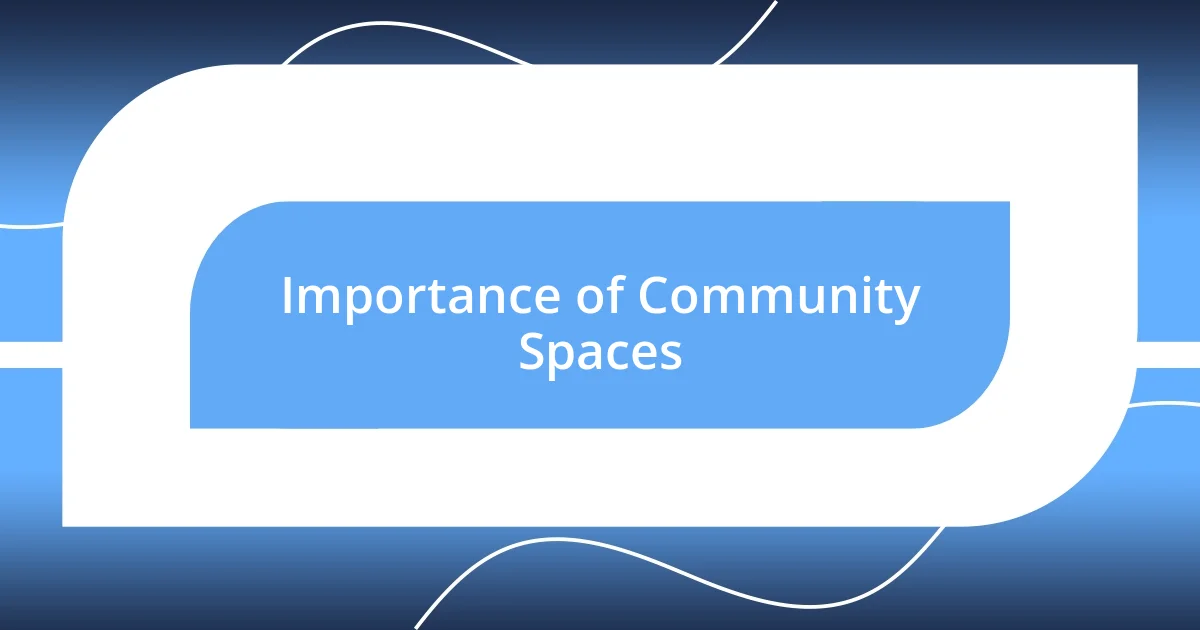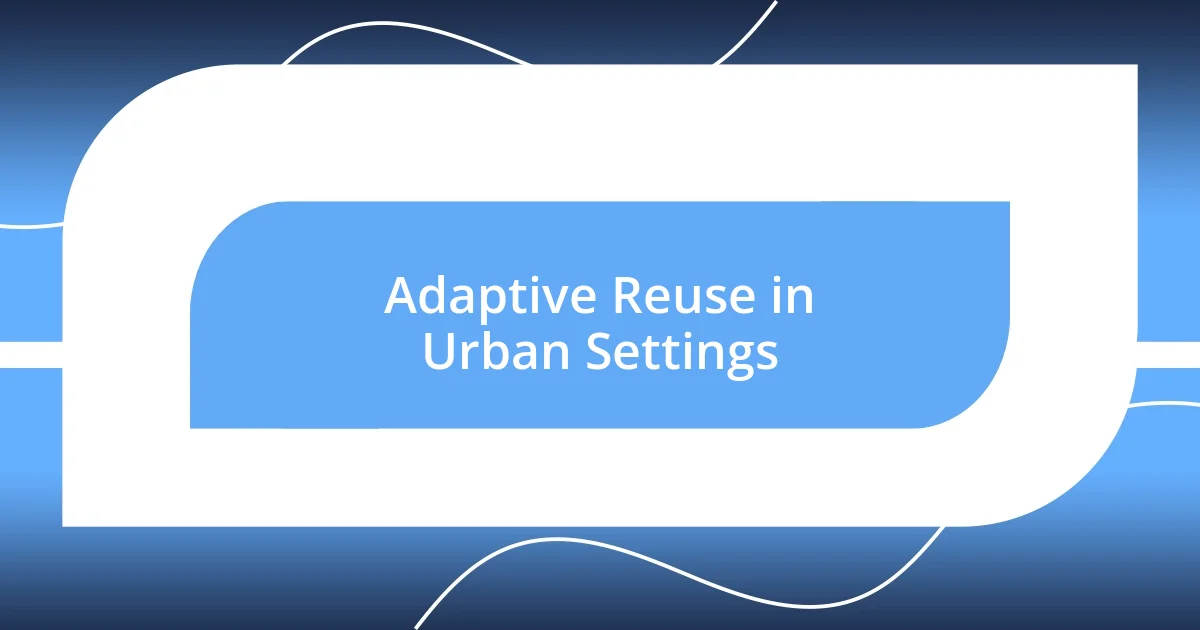Key takeaways:
- Sustainability is a central trend in urban architecture, emphasizing the integration of green building techniques and community-driven design.
- Adaptive reuse of old buildings not only honors historical significance but also promotes sustainable practices and community connectivity.
- The future of urban design will prioritize green infrastructure, mixed-use developments, and advanced technologies to enhance community engagement and livability.

Current Urban Architectural Trends
One prominent trend I’ve noticed in urban architecture is the push for sustainability. Architects are now embracing green building techniques, integrating nature into their designs. I remember walking through a neighborhood where vertical gardens adorned the sides of buildings, leaving me in awe of how nature could harmoniously coexist with urban living. Have you experienced that feeling of peace in an otherwise bustling city?
Adaptive reuse has also gained traction, turning old structures into vibrant spaces that honor history while serving modern needs. This practice resonates with me deeply; it’s like giving a second life to buildings that hold stories from the past. I once visited a former warehouse transformed into a chic café, and it sparked joy to see the original features highlighted against contemporary decor. How stories can shape our spaces, right?
Finally, I can’t overlook the increasing importance of community-driven design. Architects are now prioritizing public input, creating spaces that genuinely reflect the needs and desires of local residents. The last time I participated in a design forum, I felt empowered sharing my thoughts. It was thrilling to witness how collective voices can shape dynamic urban landscapes. Isn’t it fascinating how this approach can foster a sense of ownership and belonging among residents?

Impact of Sustainability in Design
Sustainability in design goes beyond aesthetic appeal; it’s a commitment to creating spaces that benefit both the environment and society. I often find myself reflecting on the impact of using sustainable materials and energy-efficient systems. For example, I remember touring a building designed with solar panels and rainwater collection systems. It amazed me to see how these elements not only reduced energy costs but also promoted a sense of environmental responsibility among its occupants. It truly felt like every choice made in that space contributed to a larger purpose.
- Incorporation of natural materials like reclaimed wood reduces waste and enhances the authenticity of structures.
- Green roofs and vertical gardens improve air quality and provide habitats for urban wildlife, connecting us more closely to nature.
- Energy-efficient designs, including LED lighting and high-performance windows, significantly lower energy consumption, proving that design and eco-friendliness go hand in hand.
- Biophilic design, which integrates natural elements into the built environment, promotes well-being and reduces stress for residents.
I’ve seen firsthand how these sustainable practices not only enhance the functionality of buildings but also foster a deeper connection between people, space, and nature.

Integration of Technology in Architecture
The integration of technology in architecture is reshaping our built environment in profound ways. For instance, I’ve marveled at how smart building systems optimize energy usage. During a recent visit to a high-tech office building, I was impressed by how occupancy sensors adjusted lighting and temperature according to real-time needs. Can you imagine how much energy we would save if all buildings operated this way?
Moreover, the advent of 3D printing has revolutionized construction processes. I witnessed a demonstration where intricate designs were printed on-site, reducing material waste and speeding up project timelines. This blend of creativity and efficiency truly left me in awe, as it opened the door to innovative architectural forms that were once thought impossible.
On a more personal note, I’ve become increasingly excited about virtual and augmented reality applications in architecture. I remember stepping into a VR model of a proposed community center, which allowed me to explore the space before it was even built. The experience was surreal, fostering a sense of connection to the project that I had never felt before. Isn’t it amazing how technology can bridge the gap between concepts and reality?
| Technology Integration | Impact on Architecture |
|---|---|
| Smart Building Systems | Enhances energy efficiency and occupant comfort |
| 3D Printing | Reduces material waste and accelerates construction |
| Virtual Reality | Allows immersive exploration of designs before construction |

Importance of Community Spaces
Community spaces play a crucial role in shaping the vibrancy of urban environments. I’ve often found myself relaxing in a local park, watching families interact, and it struck me how these spaces foster a sense of belonging. They serve as the heart of neighborhoods, allowing residents to gather, communicate, and forge connections.
When I attended a community event at a newly designed plaza, I felt an overwhelming sense of joy and unity among the attendees. It was fascinating to observe how the design of the space encouraged activities like open-air markets and art installations. Could it be that a well-thought-out community area has the power to transform our mundane routines into celebratory experiences?
In my experience, well-designed community spaces can significantly enhance the quality of urban life. For instance, I remember a beautifully integrated community garden that not only provided fresh produce but also became a hub for workshops and gatherings. Moments like these create not just physical amenities but a shared sense of purpose and community pride. Isn’t it heartening to think that these spaces can bring people together, breaking down barriers and building relationships?

Reimagining Urban Mobility Solutions
Reimagining urban mobility solutions is an exciting venture, especially with the rise of micromobility options like e-scooters and bike-sharing programs. I remember the first time I tried an e-scooter in my city; it was liberating! I zipped through the streets, feeling a rush of freedom while simultaneously contributing to reduced traffic congestion. Have you ever felt that sense of joy in discovering an alternative way to get around? It’s incredible how these solutions can change our relationship with urban spaces.
Another fascinating development is the integration of smart transportation systems. The other day, while waiting for a bus that was displayed in real-time on my app, I marveled at how technology seamlessly connects travel modes. When I stepped onto that bus, I felt a wave of relief knowing I wouldn’t have to scramble to catch connections. This kind of smart technology not only enhances convenience but also encourages individuals to choose public transit over cars, which has lasting benefits for our environment, right?
I’ve been particularly intrigued by the concept of mobility as a service (MaaS), which brilliantly combines various transportation options into a single accessible and user-friendly platform. Just last week, I explored an app that allowed me to plan a route combining my walk, bus ride, and even an e-bike rental. It dawned on me how empowering this could be for everyone. Can you envision a day when urban mobility is no longer limited by personal vehicle ownership but enhanced by a multifaceted network that easily adapts to our needs? It’s a thrilling prospect that could reframe urban commuting for generations to come.

Adaptive Reuse in Urban Settings
Adaptive reuse in urban settings is a remarkable trend that showcases the creativity of architects and developers alike. I once visited a former factory transformed into a vibrant arts center, and the energy of that place was palpable. It felt like the building breathed new life, blending its industrial history with modern artistic expression. Isn’t it fascinating how spaces can evolve, telling new stories while honoring their past?
I’ve noticed that these conversions not only preserve historical architecture but also contribute to sustainable urban living. For instance, turning old warehouses into residential lofts helps maximize existing structures rather than creating new ones. I often wonder, could this approach be the key to solving our urban housing crises? The benefits seem clear: they maintain character while reducing the environmental footprint.
Reflecting on my own experiences, I recall a community garden nestled within an old school building’s courtyard. The juxtaposition of nature against the worn bricks was striking. It sparked conversations among people who would typically never mingle. I can’t help but think that adaptive reuse fosters connectivity, weaving together new and old while revitalizing neighborhoods. How powerful is that blend of history and community in shaping our urban landscapes?

Future Directions in Urban Design
The future of urban design is leaning toward green infrastructure, which I find incredibly inspiring. The other day, I walked through a park that had been integrated into a busy urban area, and it felt like a breath of fresh air amid the concrete jungle. These parks not only improve air quality but also promote well-being by providing spaces for community engagement. Don’t you think such environments encourage healthier lifestyles for city dwellers?
There’s also a noticeable shift toward mixed-use developments, which aim to blend residential, commercial, and recreational spaces. Recently, I visited a redevelopment project that combined shops, apartments, and green spaces all in one place. The atmosphere was inviting, filled with families enjoying the outdoors while grabbing a bite to eat. It made me realize how this approach fosters a sense of community and convenience, encouraging people to spend more time in their neighborhoods. Isn’t it refreshing to think of urban areas as vibrant ecosystems rather than mere collections of buildings?
Lastly, the inclusion of advanced technologies like digital twins in urban planning seems like a game-changer. I remember seeing a demonstration of a virtual model of a city, where planners could visualize the effects of potential developments in real-time. This not only enhances decision-making but ensures that urban spaces meet the needs of their communities effectively. As cities evolve, can you imagine how this technology will empower residents to actively participate in shaping their environments? It’s an exciting possibility that could redefine community engagement in urban design.














